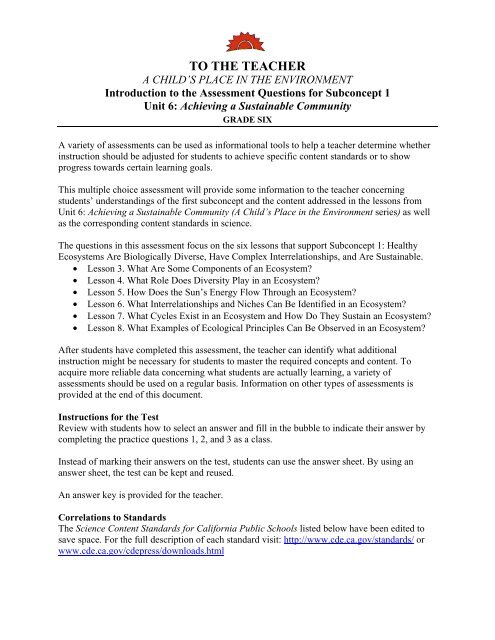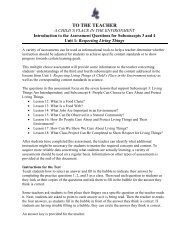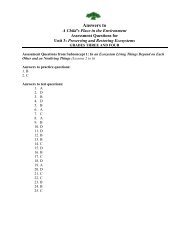Unit 6 Subconcept 1 - A Child's Place in the Environment (ACPE)
Unit 6 Subconcept 1 - A Child's Place in the Environment (ACPE)
Unit 6 Subconcept 1 - A Child's Place in the Environment (ACPE)
Create successful ePaper yourself
Turn your PDF publications into a flip-book with our unique Google optimized e-Paper software.
TO THE TEACHER<br />
A CHILD’S PLACE IN THE ENVIRONMENT<br />
Introduction to <strong>the</strong> Assessment Questions for <strong>Subconcept</strong> 1<br />
<strong>Unit</strong> 6: Achiev<strong>in</strong>g a Susta<strong>in</strong>able Community<br />
GRADE SIX<br />
A variety of assessments can be used as <strong>in</strong>formational tools to help a teacher determ<strong>in</strong>e whe<strong>the</strong>r<br />
<strong>in</strong>struction should be adjusted for students to achieve specific content standards or to show<br />
progress towards certa<strong>in</strong> learn<strong>in</strong>g goals.<br />
This multiple choice assessment will provide some <strong>in</strong>formation to <strong>the</strong> teacher concern<strong>in</strong>g<br />
students’ understand<strong>in</strong>gs of <strong>the</strong> first subconcept and <strong>the</strong> content addressed <strong>in</strong> <strong>the</strong> lessons from<br />
<strong>Unit</strong> 6: Achiev<strong>in</strong>g a Susta<strong>in</strong>able Community (A Child’s <strong>Place</strong> <strong>in</strong> <strong>the</strong> <strong>Environment</strong> series) as well<br />
as <strong>the</strong> correspond<strong>in</strong>g content standards <strong>in</strong> science.<br />
The questions <strong>in</strong> this assessment focus on <strong>the</strong> six lessons that support <strong>Subconcept</strong> 1: Healthy<br />
Ecosystems Are Biologically Diverse, Have Complex Interrelationships, and Are Susta<strong>in</strong>able.<br />
• Lesson 3. What Are Some Components of an Ecosystem?<br />
• Lesson 4. What Role Does Diversity Play <strong>in</strong> an Ecosystem?<br />
• Lesson 5. How Does <strong>the</strong> Sun’s Energy Flow Through an Ecosystem?<br />
• Lesson 6. What Interrelationships and Niches Can Be Identified <strong>in</strong> an Ecosystem?<br />
• Lesson 7. What Cycles Exist <strong>in</strong> an Ecosystem and How Do They Susta<strong>in</strong> an Ecosystem?<br />
• Lesson 8. What Examples of Ecological Pr<strong>in</strong>ciples Can Be Observed <strong>in</strong> an Ecosystem?<br />
After students have completed this assessment, <strong>the</strong> teacher can identify what additional<br />
<strong>in</strong>struction might be necessary for students to master <strong>the</strong> required concepts and content. To<br />
acquire more reliable data concern<strong>in</strong>g what students are actually learn<strong>in</strong>g, a variety of<br />
assessments should be used on a regular basis. Information on o<strong>the</strong>r types of assessments is<br />
provided at <strong>the</strong> end of this document.<br />
Instructions for <strong>the</strong> Test<br />
Review with students how to select an answer and fill <strong>in</strong> <strong>the</strong> bubble to <strong>in</strong>dicate <strong>the</strong>ir answer by<br />
complet<strong>in</strong>g <strong>the</strong> practice questions 1, 2, and 3 as a class.<br />
Instead of mark<strong>in</strong>g <strong>the</strong>ir answers on <strong>the</strong> test, students can use <strong>the</strong> answer sheet. By us<strong>in</strong>g an<br />
answer sheet, <strong>the</strong> test can be kept and reused.<br />
An answer key is provided for <strong>the</strong> teacher.<br />
Correlations to Standards<br />
The Science Content Standards for California Public Schools listed below have been edited to<br />
save space. For <strong>the</strong> full description of each standard visit: http://www.cde.ca.gov/standards/ or<br />
www.cde.ca.gov/cdepress/downloads.html
Lessons 3 through 8 <strong>in</strong> Achiev<strong>in</strong>g a Susta<strong>in</strong>able Community address <strong>the</strong> follow<strong>in</strong>g science<br />
content standards for California schools for grade six:<br />
5a – Energy enter<strong>in</strong>g ecosystems as sunlight transfers <strong>in</strong>to chemical energy through<br />
photosyn<strong>the</strong>sis; passes from organism to organism <strong>in</strong> food webs.<br />
5b – Matter transfers from one organism to ano<strong>the</strong>r <strong>in</strong> <strong>the</strong> food web; also between organisms<br />
and physical environment.<br />
5c – Organisms can be categorized by functions served <strong>in</strong> ecosystem.<br />
5d – Different k<strong>in</strong>ds of organisms may play similar ecological roles <strong>in</strong> similar biomes.<br />
5e – Number and types of organisms an ecosystem can support depend on resources<br />
available.<br />
7a – Develop a hypo<strong>the</strong>sis.<br />
7b – Select, use appropriate tools, technology to perform tests, collect and display data.<br />
7c – Construct appropriate graphs from data and <strong>in</strong>terpret data.<br />
7d – Communicate <strong>in</strong> writ<strong>in</strong>g and orally <strong>the</strong> steps, results from an <strong>in</strong>vestigation.<br />
7f – Read topographic, geologic maps.<br />
O<strong>the</strong>r Types of Assessments<br />
This assessment should not be viewed as <strong>the</strong> only way to assess students. Us<strong>in</strong>g <strong>the</strong> constructive<br />
response method that has students write explanations, rationale, predictions, and experimental<br />
design is an effective way to determ<strong>in</strong>e what students are learn<strong>in</strong>g. Not only should questions be<br />
used to prompt learners to demonstrate <strong>the</strong>ir knowledge and understand<strong>in</strong>g, but also a variety of<br />
tasks could show what skills students have learned. For example, performance-based tasks allow<br />
students to show what <strong>the</strong>y understand by apply<strong>in</strong>g <strong>the</strong>ir knowledge to various situations. For<br />
<strong>in</strong>formation on various types of assessments, guidel<strong>in</strong>es for us<strong>in</strong>g assessments, etc. visit <strong>the</strong><br />
follow<strong>in</strong>g websites:<br />
• “Assessment for Learn<strong>in</strong>g” from <strong>the</strong> Qualifications and Curriculum Authority <strong>in</strong> London<br />
(“Assessment for Learn<strong>in</strong>g is <strong>the</strong> process of seek<strong>in</strong>g and <strong>in</strong>terpret<strong>in</strong>g evidence for use by<br />
learners and <strong>the</strong>ir teachers to decide where <strong>the</strong> learners are <strong>in</strong> <strong>the</strong>ir learn<strong>in</strong>g, where <strong>the</strong>y need<br />
to go and how best to get <strong>the</strong>re.”)<br />
http://www.qca.org.uk/ca/5-14/afl/<br />
• “Assessment for Learn<strong>in</strong>g: 10 Pr<strong>in</strong>ciples” from The Assessment Reform Group Institute of<br />
Education University of London (“The aim of <strong>the</strong> Assessment Reform Group is to ensure<br />
that public policy at all levels takes account of relevant research <strong>in</strong> assessment practice.”)<br />
http://www.assessment-reform-group.org.uk/pr<strong>in</strong>ciples.html<br />
• “Assessment” from WestEd <strong>in</strong> San Francisco (“Specialists at WestEd create resource<br />
materials <strong>in</strong> assessment design and provide services <strong>in</strong> <strong>the</strong> development, implementation,<br />
and evaluation of state and local assessments — tests that measure <strong>the</strong> performance of<br />
teachers as well as students.”)<br />
http://www.wested.org/
A Child’s <strong>Place</strong> <strong>in</strong> <strong>the</strong> <strong>Environment</strong><br />
ASSESSMENT QUESTIONS FOR UNIT 6:<br />
Achiev<strong>in</strong>g a Susta<strong>in</strong>able Community<br />
GRADE SIX<br />
<strong>Subconcept</strong> 1: Healthy Ecosystems Are Biologically Diverse, Have<br />
Complex Interrelationships, and Are Susta<strong>in</strong>able (Lessons 3 to 8)<br />
Name: _____________________________________ Date:___________________<br />
Complete <strong>the</strong> follow<strong>in</strong>g two practice questions as a class:<br />
Animals can be grouped <strong>in</strong> different ways. Sixth-grade students at<br />
Lake Arrowhead Middle School recorded <strong>in</strong>formation regard<strong>in</strong>g four<br />
animals on <strong>the</strong> follow<strong>in</strong>g chart.<br />
Grasses<br />
Animal 1 X X<br />
Field<br />
mice<br />
Food Sources<br />
Decay<strong>in</strong>g<br />
field mice<br />
Beetles<br />
-1-<br />
Wildflowers<br />
Jackrabbits<br />
Animal 2 X X<br />
Animal 3 X X X<br />
Animal 4 X X<br />
Decay<strong>in</strong>g<br />
jackrabbits<br />
Earthworms<br />
1. Which does Animal 4 eat?<br />
! A. Field mice, decay<strong>in</strong>g field mice, and jackrabbits<br />
! B. Grasses and wildflowers<br />
! C. Grasses, beetles, and earthworms<br />
! D. Decay<strong>in</strong>g field mice and decay<strong>in</strong>g jackrabbits<br />
2. Based on what it eats, which of <strong>the</strong> follow<strong>in</strong>g might Animal 4 be?<br />
! A. An herbivore<br />
! B. A scavenger<br />
! C. A carnivore<br />
! D. An omnivore
Sixth-grade students at <strong>the</strong> Lakeport Elementary School made a solar<br />
still by:<br />
• digg<strong>in</strong>g a hole <strong>in</strong> <strong>the</strong> ground<br />
• plac<strong>in</strong>g a jar <strong>in</strong> <strong>the</strong> center of <strong>the</strong> bottom of <strong>the</strong> hole<br />
• drap<strong>in</strong>g a piece of plastic over <strong>the</strong> hole<br />
• shap<strong>in</strong>g <strong>the</strong> plastic to form a funnel and rest<strong>in</strong>g <strong>the</strong> tip of <strong>the</strong><br />
funnel-shaped plastic <strong>in</strong>side <strong>the</strong> conta<strong>in</strong>er<br />
• secur<strong>in</strong>g <strong>the</strong> plastic with two rocks<br />
After two days <strong>the</strong> students observed water <strong>in</strong> <strong>the</strong> conta<strong>in</strong>er.<br />
3. How did <strong>the</strong> water get <strong>in</strong>to <strong>the</strong> conta<strong>in</strong>er?<br />
! A. The sun evaporated <strong>the</strong> water from <strong>the</strong> soil. The water evaporated from<br />
<strong>the</strong> plastic and condensed <strong>in</strong>side <strong>the</strong> jar.<br />
! B. Heat from <strong>the</strong> sun evaporated <strong>the</strong> water from <strong>the</strong> soil. The water<br />
condensed on <strong>the</strong> plastic and ran down <strong>the</strong> funnel <strong>in</strong>to <strong>the</strong> jar.<br />
! C. The sun conducted <strong>the</strong> water from <strong>the</strong> soil. The water condensed on <strong>the</strong><br />
plastic and dried up before it could run down <strong>the</strong> funnel and <strong>in</strong>to <strong>the</strong> jar.<br />
! D. The sun did not do anyth<strong>in</strong>g to <strong>the</strong> water <strong>in</strong> <strong>the</strong> soil. A student came back<br />
at night when no one was around and filled <strong>the</strong> conta<strong>in</strong>er with water.<br />
BEGIN TEST<br />
Questions for Lesson 3<br />
1. Which of <strong>the</strong> follow<strong>in</strong>g are components of an ecosystem?<br />
! A. Only sunlight and no plants or animals<br />
! B. Only plants and animals and no water<br />
! C. Only nonliv<strong>in</strong>g th<strong>in</strong>gs, like water, air, and soil<br />
! D. Liv<strong>in</strong>g and nonliv<strong>in</strong>g th<strong>in</strong>gs<br />
2. What is <strong>the</strong> primary source of energy <strong>in</strong> an ecosystem?<br />
! A. Plants<br />
! B. Sunlight<br />
! C. Animals<br />
! D. Natural cycles<br />
-2-
3. How is soil important to an ecosystem?<br />
! A. Soil conta<strong>in</strong>s sand.<br />
! B. Soil provides nutrients to plants.<br />
! C. Soil is not important <strong>in</strong> an ecosystem.<br />
! D. Soil provides energy to <strong>the</strong> ecosystem.<br />
4. Which diagram below describes <strong>the</strong> flow of energy <strong>in</strong> a food cha<strong>in</strong> <strong>in</strong> a grassland<br />
ecosystem?<br />
! A. Gra<strong>in</strong> Mouse Snake Hawk<br />
! B. Hawk Mouse Snake Gra<strong>in</strong><br />
! C. Gra<strong>in</strong> Hawk Snake Mouse<br />
! D. Gra<strong>in</strong> Snake Mouse Hawk<br />
5. In a grassland ecosystem, a snake would be best adapted to eat which of <strong>the</strong><br />
follow<strong>in</strong>g?<br />
! A. Coyote ! B. Plant ! D. Butterfly ! D. Mouse<br />
6. Which diagram below describes <strong>the</strong> flow of energy <strong>in</strong> a food cha<strong>in</strong> <strong>in</strong> an ocean<br />
ecosystem?<br />
! A. Sea urch<strong>in</strong> Sea otter Kelp<br />
! B. Kelp Sea otter Sea urch<strong>in</strong><br />
! C. Kelp Sea urch<strong>in</strong> Sea otter<br />
! D. Sea otter Sea urch<strong>in</strong> Kelp<br />
7. In an ocean ecosystem, a pelican would be best adapted to eat which of <strong>the</strong><br />
follow<strong>in</strong>g?<br />
! A. Whales<br />
! B. Seagulls<br />
! C. Kelp<br />
! D. Fish<br />
Questions for Lesson 4<br />
8. What is biodiversity?<br />
! A. Many animals and plants of a few species<br />
! B. Many nonliv<strong>in</strong>g th<strong>in</strong>gs<br />
! C. One type of plant or animal<br />
! D. Animals and plants of many species<br />
-3-
9. Which of <strong>the</strong> follow<strong>in</strong>g helps an ecosystem rema<strong>in</strong> stable?<br />
! A. Habitat alteration<br />
! B. Pollution<br />
! C. Biodiversity<br />
! D. Human activities<br />
Peter and Rita caught a butterfly <strong>in</strong> a net and placed it <strong>in</strong> a jar. They<br />
observed <strong>the</strong> characteristics of <strong>the</strong> butterfly’s w<strong>in</strong>gs before lett<strong>in</strong>g it go.<br />
10. Which of <strong>the</strong> follow<strong>in</strong>g is not an observation?<br />
! A. Pretty or not so pretty<br />
! B. Shape and color<br />
! C. Number of legs and w<strong>in</strong>gs<br />
! D. Design and size<br />
Questions for Lesson 5<br />
11. What role does sunlight play <strong>in</strong> photosyn<strong>the</strong>sis?<br />
! A. It makes <strong>the</strong> plant warm.<br />
! B. It provides energy.<br />
! C. It provides oxygen.<br />
! D. It makes chlorophyll.<br />
12. What gas do plants give off dur<strong>in</strong>g <strong>the</strong> process of photosyn<strong>the</strong>sis that is used<br />
by animals?<br />
! A. Oxygen<br />
! B. Water<br />
! C. Carbon monoxide<br />
! D. Sugar<br />
Tara’s sixth-grade class was learn<strong>in</strong>g about photosyn<strong>the</strong>sis. As part of<br />
<strong>the</strong>ir lesson, <strong>the</strong> class learned that CO 2 is <strong>the</strong> symbol for carbon<br />
dioxide and H 2 O is <strong>the</strong> symbol for water.<br />
13. Dur<strong>in</strong>g <strong>the</strong> process of photosyn<strong>the</strong>sis:<br />
! A. sugar and water turn <strong>in</strong>to CO 2 and H 2 O.<br />
! B. CO 2 and H 2 O are converted to oxygen and sugar.<br />
! C. poll<strong>in</strong>ators are attracted to H 2 O.<br />
! D. oxygen and CO 2 are turned <strong>in</strong>to H 2 O.<br />
-4-
14. Matter is transferred <strong>in</strong> an ecosystem from:<br />
! A. sunlight to a producer.<br />
! B. a consumer to a producer.<br />
! C. sunlight to a consumer.<br />
! D. a producer to a consumer.<br />
Questions for Lesson 6<br />
15. What function does a scavenger serve <strong>in</strong> an ecosystem?<br />
! A. It saves parts of live organisms to eat at ano<strong>the</strong>r time.<br />
! B. It eats only plants.<br />
! C. It eats parts of dead organisms.<br />
! D. It eats parts of live plants and animals.<br />
16. What is an omnivore?<br />
! A. An organism that eats only animals<br />
! B. An organism that eats only plants<br />
! C. An organism that eats only dead organisms<br />
! D. An organism that eats both plants and animals<br />
17. What is a producer?<br />
! A. An organism that eats only live plants<br />
! B. An organism that eats only dead th<strong>in</strong>gs<br />
! C. An organism that decomposes th<strong>in</strong>gs<br />
! D. An organism that makes its own food<br />
bird beetle coyote grass<br />
18. Put <strong>the</strong> organisms above <strong>in</strong> order to show <strong>the</strong> flow of energy <strong>in</strong> a food cha<strong>in</strong>.<br />
! A. bird beetle coyote grass<br />
! B. coyote bird beetle grass<br />
! C. grass bird beetle coyote<br />
! D. grass beetle bird coyote<br />
-5-
Animals can be grouped <strong>in</strong> different ways. Sixth-grade students<br />
at Lake Arrowhead Middle School recorded <strong>in</strong>formation regard<strong>in</strong>g<br />
four animals on <strong>the</strong> follow<strong>in</strong>g chart.<br />
Grasses<br />
Animal 1 X X<br />
Field<br />
mice<br />
Food Sources<br />
Decay<strong>in</strong>g<br />
field mice<br />
Beetles<br />
-6-<br />
Wildflowers<br />
Jackrabbits<br />
Animal 2 X X<br />
Animal 3 X X X<br />
Animal 4 X X<br />
19. Which animal above is an omnivore?<br />
! A. Animal 1<br />
! B. Animal 2<br />
! C. Animal 3<br />
! D. Animal 4<br />
20. Which animal above is a carnivore?<br />
! A. Animal 1<br />
! B. Animal 2<br />
! C. Animal 3<br />
! D. Animal 4<br />
21. Which animal above is an herbivore?<br />
! A. Animal 1<br />
! B. Animal 2<br />
! C. Animal 3<br />
! D. Animal 4<br />
Decay<strong>in</strong>g<br />
jackrabbits<br />
Earthworms<br />
22. In an ecosystem, some animals depend on o<strong>the</strong>r animals for:<br />
! A. protection from <strong>in</strong>sects that eat plants.<br />
! B. food.<br />
! C. a source of water and oxygen.<br />
! D. dispers<strong>in</strong>g seeds.<br />
23. What is a niche?<br />
! A. The role that an organism plays <strong>in</strong> an ecosystem<br />
! B. What organisms <strong>in</strong> an ecosystem eat<br />
! C. Someth<strong>in</strong>g that is liv<strong>in</strong>g outside an ecosystem<br />
! D. Organisms that make <strong>the</strong>ir own food
Questions for Lesson 7<br />
24. Which of <strong>the</strong> follow<strong>in</strong>g describes <strong>the</strong> order of <strong>the</strong> stages of <strong>the</strong> water cycle?<br />
! A. Condensation, evaporation, precipitation<br />
! B. Evaporation, condensation, precipitation<br />
! C. Precipitation, condensation, evaporation<br />
! D. Evaporation, precipitation, condensation<br />
25. Why is <strong>the</strong> process of decomposition important <strong>in</strong> an ecosystem?<br />
! A. It causes <strong>the</strong> animals with<strong>in</strong> an ecosystem to die.<br />
! B. It promotes metamorphosis among liv<strong>in</strong>g th<strong>in</strong>gs throughout an ecosystem.<br />
! C. It provides oxygen for <strong>the</strong> animal’s tissues.<br />
! D. It breaks down dead organisms to provide nutrients for liv<strong>in</strong>g th<strong>in</strong>gs.<br />
26. The sun’s energy reaches Earth through:<br />
! A. conduction.<br />
! B. radiation.<br />
! C. convection.<br />
! D. condensation.<br />
A group of sixth-grade students at <strong>the</strong> Shasta County Outdoor School<br />
were learn<strong>in</strong>g about <strong>the</strong> role of life cycles <strong>in</strong> an ecosystem. They were<br />
learn<strong>in</strong>g about <strong>the</strong> four stages of <strong>the</strong> life cycle of <strong>the</strong> butterfly.<br />
Caterpillar Butterfly Eggs Chrysalis<br />
27. Put <strong>the</strong> stages of <strong>the</strong> life cycle for <strong>the</strong> butterfly <strong>in</strong> order.<br />
! A. Butterfly, egg, chrysalis, caterpillar<br />
! B. Egg, chrysalis, caterpillar, butterfly<br />
! C. Chrysalis, egg, caterpillar, butterfly<br />
! D. Egg, caterpillar, chrysalis, butterfly<br />
-7-
Questions for Lesson 8<br />
28. What rule is not important when explor<strong>in</strong>g an ecosystem?<br />
! A. Treat all liv<strong>in</strong>g th<strong>in</strong>gs with respect.<br />
! B. Be safe.<br />
! C. Go wherever you want to go without tell<strong>in</strong>g anyone.<br />
! D. Do not litter.<br />
29. What is not evidence that wildlife lives <strong>in</strong> <strong>the</strong> area?<br />
! A. Hair on a tree.<br />
! B. Dropp<strong>in</strong>gs of <strong>the</strong> ground.<br />
! C. Paw pr<strong>in</strong>ts <strong>in</strong> <strong>the</strong> mud.<br />
! D. Tire tracks on <strong>the</strong> soil.<br />
30. Which of <strong>the</strong> follow<strong>in</strong>g is not a component of soil?<br />
! A. Rock particles<br />
! B. Water<br />
! C. Paper<br />
! D. Organic matter<br />
31. Which change <strong>in</strong> an ecosystem is usually made only by nature?<br />
! A. Earthquake<br />
! B. Fire.<br />
! C. Clear<strong>in</strong>g land for construction.<br />
! D. Cutt<strong>in</strong>g down trees for lumber and firewood.<br />
Mandy and Tiffany went on a field trip where <strong>the</strong>y<br />
conducted an <strong>in</strong>vestigation of soil.<br />
32. What characteristics of <strong>the</strong> soil might <strong>the</strong>y observe?<br />
! A. The color, texture, size, and shape of soil particles<br />
! B. The shapes <strong>in</strong> nature that soil particles look like<br />
! C. Whe<strong>the</strong>r <strong>the</strong> soil particles are pretty or not pretty<br />
! D. The conta<strong>in</strong>ers that <strong>the</strong> soil was put <strong>in</strong>to<br />
-8-




